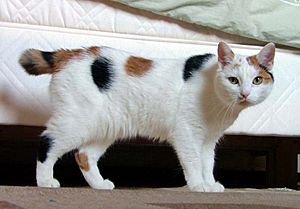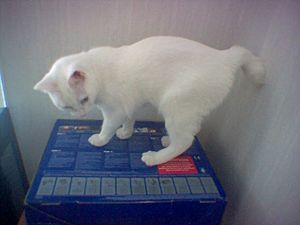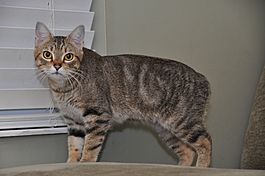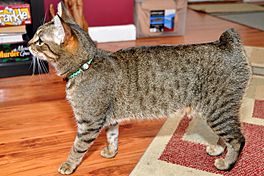Manx (cat) facts for kids
The Manx is a breed of domestic cat. It either has no tail at all, a "rumpy", or it has a very short tail, a "stumpy". This is because of a natural difference in spine length. The back legs are also longer than the front legs. The breed comes from the Isle of Man, where it was found as early as three hundred years ago.
The Manx's character is nervous. The Manx's appearance is round on the whole. They are skilled hunters.
Contents
Appearance
Tail (or lack thereof)
Although tail suppression (or tail length variety) is not the sole characteristic feature of the breed, the chief defining one of the Manx cat is its absence of a tail to having a tail of long length, or tail of any length between the two extremes. This is a naturally occurring, cat body-type mutation of the spine, caused by a dominant gene. As with the sometimes-tail-suppressed Schipperke dog and Old English Sheepdog, tail suppression does not "breed true" in Manx cats. Attempting to force the tailless trait to breed true by continually breeding tailless Manx cats to tailless Manx cats has led to increased negative, even fatal genetic disorders (see below). Tail length is random throughout a litter of kittens. Manx to non-Manx breeding will usually produce some Manx-type tail varieties in kittens. Whether the shorter tailed kittens of these varieties are labeled Manx is up to the breed standard consulted. Manx cats' tails are classified according to proportional tail length as kittens (the proportion does not change after birth):
- Rumpy (rumpie) or dimple rumpy – having no tail at all, though often a tuft of hair where the tail would have grown from the rump
- Riser or rumpy riser – having a bump of cartilage under the fur, most noticeable when the animal is happy and raising its tail end
- Stumpy (stumpie) – having a partial tail of vestigial, fused vertebrae, up to about 3 cm (1 in) long
- Stubby (stubbie), shorty, or short-tailed – having a short tail of non-fused bones, up to about half an average cat tail
- Longy (longie), tailed, or taily (tailie) – having a half- to normal-length tail.
Since the early days of breed recognition in the late 19th century, Manx show cats have been rumpy through stumpy specimens, with stubby and longy Manx not qualifying to be shown except in the "Any Other Variety" or household pet class. Kittens with complete tails may be born in a purebred Manx litter, having not inherited the taillessness appearance at all. Depending on the country and cat organization referenced, rumpy, rumpy risers and stumpies are the only Manx cat tail types that fit the breed standard for Manx cats. The longer cat tail lengths seen in some Manx cats are considered a breed fault, although they occur as naturally in the breed, but not as often, as the shorter tails. Although these longer tail types are of purebred Manx ancestry, they do not possess the dominant gene so cannot pass it on. However, since the Manx tail mutation gene is dominant, these longer-tailed purebred Manx cats may still be used in breeding programs and may even be considered in an effort to help avoid the fatal spinal deformities that sometimes result in tailless Manx cats.
The Manx breed is genetically distinct from the Japanese Bobtail breed, another naturally occurring insular breed. The Japanese Bobtail always has at least some tail, ranging from a small "pom" to a stubby but distinct tail, which is kinked or curled and usually has a slightly bulbous and fluffy appearance; by contrast, the Manx has a straight tail when one is present at all. The Japanese Bobtail has a markedly different appearance from the Manx, and is characterized by almond-shaped eyes, a triangular face, long ears, and lean body, like many other Asian breeds. The gene responsible for the bobbed or kinked tail in that breed is recessive and unrelated to the dominant Manx tail-suppression gene; the bobtail gene is not connected to any serious deformities, while the tail-suppression gene can, under certain conditions, give rise to a pattern of sometimes lethal health problems. The Pixie-bob breed also has a short tail which may or may not be genetically related or identical to that of the Manx. More will be clear about tail genetics as more genetic studies are done on cat populations and as DNA testing improves; most domestic animal genetic work has been done with dogs and livestock breeds.
Manx (and other tail-suppressed breeds) do not exhibit problems with balance, Balance is controlled primarily by the inner ear. In cats, dogs and other large-bodied mammals, balance involves but is not dependent upon the tail (contrast rats, for whom the tail is a quite significant portion of their body mass).
Since Manx kittens are naturally born with any tail length, from none to long, it was formerly common to surgically dock the longer tails a few days after birth. Although illegal in many jurisdictions today (including much of Europe), the practice was formerly recommended, although with the caveat that the commonness of the practice meant that many spurious Manx cats – i.e., random British cats – were altered to resemble the Manx, to defraud unwary buyers.
Body and legs
Manx are small to medium-sized cats, broad-chested with sloping shoulders and flat sides, and in show condition are firmly muscular and lean, neither bulky nor fatty. Lane reported the original, native, naturally occurring pure breed as ranging typically from eight to ten pounds for males and six to eight pounds for females, with many smaller examples but only rare ones larger. The hind legs of Manx are notably longer than the fore legs, causing the rump to be higher than the shoulder and creating a continuous arch from shoulders to rump giving the cat an overall rounded or humped appearance, though the breed is comparatively long when stretched out. The fore legs are strong and straight. The shape is often described as rabbit-like.
Head
Manx cats' heads are rounded in shape, and medium in depth with a long neck. The face is often very expressive, with a small nose. The upright, round-tipped and front-facing ears are largish. The eyes are large, rounded and prominent, with their outer corners higher than the inner ones. Absent any bloodlines with a dominant alternative eye color (such as blue in Siamese or related ancestry), Manx often have some hue variant of gold eyes, and for show purposes follow the eye colour standards of the same coat colour/pattern in non-Manx short-hairs.
Coat
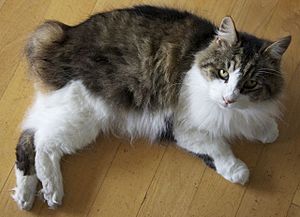
Manx cats exhibit two coat lengths. Short- or long-haired, all Manx have a thick, double-layered coat. The colour and pattern ranges exhibited should conform to the standards for that type of coat in non-Manx.
The more common short-haired Manx – the original breed – has a coat with a dense, soft, under layer and a longer, coarse outer layer with guard hairs. The overall appearance of the coat is fine, short and lying close to the skin, versus fluffy or voluminous.
The long-haired Manx, known to some cat registries as the Cymric, has a silky-textured double coat of medium length, with "breeches", belly ruff and neck ruff, tufts of fur between the toes and full "ear furnishings" (hairs in ears). The CFA considers the Cymric to be a variety of Manx and judges it in the short-hair division even though it is long-haired, while The International Cat Association (TICA) judges it in the long-hair division as a distinct Cymric breed. The long-haired variety is of comparatively recent development. Lane wrote in 1903 that the Manx "to the best of my knowledge, information and belief, does not include any long-haired specimens", in his detailed chapter on the breed.
Regardless of coat length, the colours and coat patterns occurring in the breed today run the gamut of virtually all breeds due to extensive cross-breeding, though not all registries may accept all coats as qualifying for breeding or show. The most common coats are tabby, tortoiseshell, calico and solid colours. Widely divergent Manx specimens, including even a colour-point, blue-eyed, long-haired variant of evident Himalayan ancestry, have been celebrated on Isle of Man postage stamps since the 1980s, and recent publications often show marbled and spotted varieties. The original insular stock, however, were of less widespread variation. Lane, having "seen a great many of them" wrote of Manx cats that "[i]t is curious that the colours in this variety seem somewhat limited" and that the breed "does not comprise all the colours usually associated with other short-haired varieties". He reported only very common black, common black and white, common grey-striped tabby, uncommon tortoiseshell, and very rare all-white specimens in 1903. Calico and point-coloured are notably absent from this list, as are even today's common colourful tabbies. However, writing in England only five years later, Barton suggested that "the Manx may be of any colour, but probably black is the most frequently met with." According to CFA, entirely white Manx cats still remain extremely rare. In some cases, white Manx may be worth over US$4,000.
Specific registries have particular, and differing, standards of points with regard to coloration and patterning. For example, the Governing Council of the Cat Fancy (GCCF) classifies the Manx as a variant of the British Shorthair (BSH), Some other registries are even more restrictive, while others are more liberal.
Variants (sub-breeds)
Four new, consistent varieties have been developed from the Manx (the original version of which is now sometimes consequently called the Shorthair Manx). These are the Cymric (Longhair Manx), the Isle of Man Shorthair and Isle of Man Longhair, and the Tasman Manx, though only the Cymric has garnered widespread acceptance in breed registries as of 2014[update].
Cymric (Manx Longhair)
The Cymric or Manx Longhair is a tailless or partially tailed cat of Manx stock, with semi-long to long hair, e.g. as the result of cross-breeding with Himalayan, Persian and other longer-haired breeds early in its development. While its name refers to Wales (Cymru), the breed was actually developed in Canada, which has honoured the breed with a commemorative 50-cent coin in 1999.
Simply covering it in their Manx breed standards, the US-based Cat Fanciers' Association (CFA), the Co-ordinating Cat Council of Australia (CCCA), and the UK's Governing Council of the Cat Fancy (GCCF) recognise the variety as a longer-haired Manx rather than "Cymric" (the CFA and CCCA call it the Manx Longhair, while GCCF uses the term Semi-longhair Manx Variant). The majority of cat registries have explicit Cymric standards (published separately or along with Manx). Of the major registries, only the Feline Federation Europe (FFE) does not recognise the breed or sub-breed at all, under any name, as of 2014[update] (their Manx standard was last update 17 May 2004).
Isle of Man Shorthair (tailed)
Resembling the British Shorthair, the Isle of Man Shorthair is essentially a fully tailed Manx cat. That is, it is a cat of Manx stock, with Manx features, but without any expression of the Manx taillessness gene. As of March 2013[update], it is only recognised by New Zealand Cat Fancy (NZCF) with its own breed standard. Any coat colour and pattern acceptable in the British Shorthair is permissible in the IoM Shorthair (the same restriction is applied to the Manx in the NZCF standard), and it requires the double coat of the Manx. In other international registries (e.g. GCCF, who also treat Manx as a British Shorthair variant), such cats are designated "Tailed Manx" and only recognised as Manx breeding stock (they are important as such, since breeding two tailless Manx together results in birth defects), and cannot be show cats.
Isle of Man Longhair (tailed)
Essentially a fully tailed Cymric cat, i.e., a cat of Cymric (and thus Manx) stock, the Isle of Man Longhair has Cymric features, but without expression of the Manx taillessness gene. As of March 2013[update], it is only recognised as a separate breed by NZCF with a breed standard. Coat colours are limited to those acceptable in the British Shorthair, and requires the doubled and thick, long coat of the Cymric.
Tasman Manx (curly-coated)
Named after Tasman Sea between Australia and New Zealand, the Tasman Manx is a tailless or partially tailed Manx cat with a curly-haired coat not unlike that of a Selkirk Rex, due a recessive mutation which arose in Manx litters in both Australia and New Zealand. As of March 2013[update], the breed is only recognised by the NZCF and the Catz Inc. registry (also of New Zealand) with breed standards. The coat may be short or semi-long.
Images for kids
See also
 In Spanish: Gato manx para niños
In Spanish: Gato manx para niños


